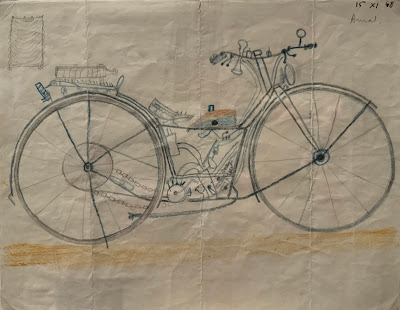Francesc Tosquelles, who fled his native Catalonia during the Spanish Civil War, introduced a kind of holistic psychiatry at an asylum in Vichy France that broke down hierarchal barriers among the staff, patients and neighboring communities. Everyone had to take turns cleaning the toilets.
The hospital where he practiced at Saint-Alban provided refuge for political prisoners as well as treatment for people mentally ill people. Tosquelles encouraged creative expression in both groups through what became known as "institutional psychotherapy."
These portraits of patients by Léon Schwarz-Abrys were exhibited after the war in Paris but viewers had difficulty determining if he had been a patient or a prisoner because the latter often deliberately blurred the lines between the two for reasons of self-preservation.
 |
| "Senile Dementia" (ca 1943-44) |
 |
| "Paranoid" (ca 1943-44) |
 |
| "Delusional Hallucinated" (ca 1943-44) |
The work produced at Saint-Albans attracted the attention of
Jean Dubuffet whose
art brut movement valued rawness over training, the id over the super ego. An
exhibition at the American Folk Art Museum noodless on the role that Tosquelles played in facilitating greater recognition for "outsider" art barely acknowledging that the Nazis were occupying France at the time.
Auguste Forestier emerged as a singular talent.
 |
| "The Wolf and the Lamb" (ca 1914) |
A farm boy obsessed with trains, he de-railed one by putting pebbles on the track. The incident led to his confinement at Saint-Alban at the age of 27 where he remained for the rest of his life. The hospital nurtured his early artistic talent by providing a safe haven. Forestier's wooden, toy-like sculptures earned the admiration of
Pablo Picasso in addition to Dubuffet, who added Forestier's work to his growing art brut collection.
The exhibit includes works by patients from other psychiatric hospitals including a huge collage by Eugene Bedeaux, a former locomotive engineer. Train obsession might even be considered an exhibition motif.
 |
| "The Symbol of My Story, or Filiation of the Locomotive" (detail, 1927-33) |
Other practitioners of institutional psychotherapy--who included
Frantz Fanon--discussed with Dubuffet the idea that exiles or refugees might visualize their dislocation uniquely. He recognized their insight when he discovered the haunting bas reliefs Joaquim Vincens Gironella carved to decorate the Parisian headquarters of his family's cork business. Like Tosquelles, Gironella and his two brothers had been forced to leave Spain by the civil war.
Dubuffet also used his own artistic talent to render individuals who created art brut in media other than painting and sculpture.
Antonin Artaud, institutionalized off and on for much of his life, introduced the world to the
Theater of Cruelty.
 |
| Antonin Artaud with Tufts by Jean Dubuffet (1947) |
Perhaps as a result of my ignorance of psychiatry's history, I found the exhibit--particularly the label text--heavy going. Here's what the curators had to say about several scenes Benjamin Arneval drew from his childhood: "Tosquelles's Saint-Alban colleague and later founder of La Borde clinic Dr. Jean Oury wrote an essay on Arneval and the latter's end-of-the-world cosmology. Oury was especially attentive to the emotional relationship that bound patients to their works. Preventing the separation of these works from the 'living whole' of the artist's immediate lifeworld was a task Oury considered 'an honest occupational therapy.'" Huh?
The museum supplemented the traveling exhibit with works from its own collection, including a nightgown embroidered by a patient at
Willard State Hospital.
My takeaway: patients enjoy art therapy and some have styles distinctive enough to generate appreciation outside the institutions where they have been confined, particularly when their work is championed by others.











No comments:
Post a Comment